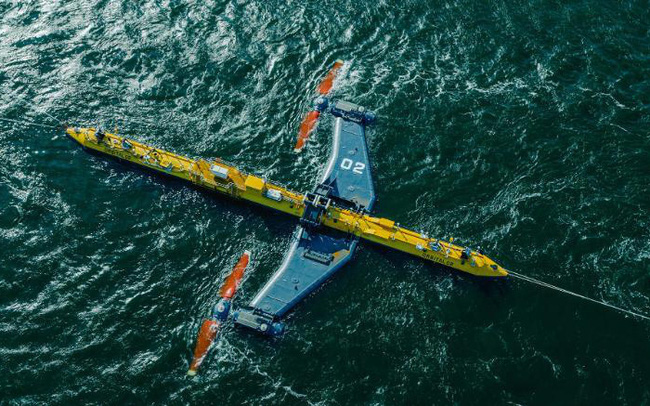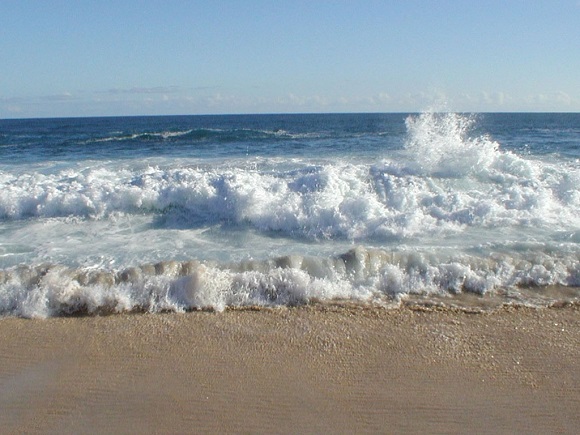Current status of tidal energy development in Vietnam
According to the assessment results of the Vietnam Institute of Energy Science, Vietnam has the potential to exploit high tidal energy sources due to many resources and geographical conditions.
Advantages and disadvantages of tidal energy sources
The advantage of the method of harnessing electricity from tidal currents is that it is an inexhaustible renewable resource, produces a lot of energy, and when it works, does not interfere with ships.

The turbine's propeller has a slow rotation speed, which does not pose too much danger to creatures living in the ocean. The design is similar to a wind turbine, but the water is more stable and easier to control, so the amount of electricity generated from tidal energy will be more even. As an inexhaustible resource, the device can be operated under any weather conditions.
However, the installation of this turbine is very complicated. The system is large in size and has the potential to seriously affect the environment. In addition, the difficulty lies in the equipment part because generators often have to be submerged in deep water, which is not convenient for operation, and sea water is a strong corrosive environment that so far there is no solution to overcome. thoroughly recovered. Therefore, the equipment is expensive and the operating costs are high.
Not only that, the disadvantage of tidal energy is that it has to depend on the ebb and flow of the tide. Influenced by many natural influences
Many countries in the world have used energy from the sea
Currently, about 100 companies worldwide are working on converting energy from the ocean into electricity. Energy from the ocean also has more potential than wind energy because water has a higher density than air. "Heavy water" is taken from a barrel of seawater, the energy of which is equivalent to 400 barrels of the finest petroleum.

In 1966, in France, built the world's first tidal power plant of an industrial scale with a capacity of 240 MW, which is one of the largest tidal power plants in the world. accounted for the highest proportion of electricity supply for the electricity industry in France.
In 1984, two decades later, Canada operated a 20 MW plant, producing 30 million kW of electricity annually, which is equivalent to the amount of electricity we get when we are using 10 350 kW industrial generators.
China is also a country that is very interested in clean energy, currently China has 7 tidal power plants in operation with a total capacity of 11 MW.
Recently, Korea has paid great attention to exploiting and using tidal energy. A 254 MW Shiwa tidal power plant was completed in 2010; In the city of Incheon since 2007 has built a factory with a capacity of 812 MW, the world's largest with 32 units and will be put into operation in 2015.
Vietnam promotes tidal energy with many advantages
When learning about wind energy, tidal currents, or ocean waves, most analyzes and assessments say that: Our country has "great potential", with attractive statistics. The problem is that although there is "a lot of quantity" but "lack of quality", it is rarely mentioned, or quite vague.

More specifically, our country has a lot of wind, tidal currents and ocean currents almost all year round, the sea surface area with waves is among the top in the world... But the speed of wind, tides and ocean currents are only at the same level. average, or weak in most of the year, low wave height… These are very important indicators affecting the success or failure of projects when deciding to invest in energy extraction technologies. renewables available in the world.
Vietnam with 3,000 km of coastline has great potential to develop energy from waves. However, unfortunately, the investment and exploitation of this clean energy source is quite slow compared to what the world has been doing. At present, marine energy development in our country is only in its very early stages. Besides, Vietnam is still quite slow in considering whether to join the International Group on Ocean Energy.
At this time, Vietnam needs to soon join international organizations to be able to effectively implement the green energy strategy, contributing to sustainable socio-economic development
In Quang Ninh area, tidal energy density is about 3.7 GWh/km2, Nghe An is about 2.5 GWh/km2 and gradually decreases to Thua Thien Hue area with 0.3 GWh/km2. To the south, Phan Thiet is 2.1 GWh/km2, Ba Ria - Vung Tau with 5.2 GWh/km2.
With the characteristics of topography and tidal regime, the Northeast sea belongs to Quang Ninh province and Ho Chi Minh City. Hai Phong is an area with the largest potential for tidal power development in the country, with an installed capacity of up to 550 MW, accounting for 96% of the technical potential of Vietnam's tidal power source. However, this energy source has not been interested in exploiting, it is at the early stage of research, and there are no specific applications for generating electricity from this energy source.
In summary, tidal energy is a relatively new renewable energy source, so there are still many difficulties, principles and technology are still experimental problems. Therefore, there are always more corrections and additions through each research. According to initial speculations, the energy produced by this inexhaustible ocean water is enough to last mankind for over 1 billion years. Or the waves, tides, ocean currents... that endure with time, can provide humanity with a huge source of energy.